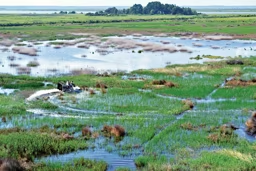Here’s a stumper: What could squeaky-clean dishes and shockingly green lakes have in common? If you answered “phosphorus,” congratulations! Phosphorus has noteworthy connections to both dishwasher detergents and excessive algae growth. Though essential for life, too much phosphorus in lakes and streams stimulates an overabundance of algae and often a shift to more noxious types. In detergents, it binds with minerals, allowing for more effective washing. And the phosphorus in detergents is the same phosphorus that has contributed to the greening of North America’s waters.
From swimmable lake to toxic stew
Excessive algal growth can reduce oxygen in the water to the point where fish and other aquatic life are gasping, if not perishing. Algal blooms can turn a swimmable lake into a toxic stew where the hazardous blue-green algae (aka cyanobacteria) can thrive.
Headlines in the 1960s suggesting that Lake Erie was “dying” from choking on algae led to studies that linked excess use of phosphorus by humans to greening lakes. Dr. David Schindler of the Department of Fisheries and Oceans, Canada, manipulated entire lakes to reveal the power of “P.” He showed that municipal wastewater contained phosphate detergents, which were a major cause of low oxygen levels, algal growth, and fish kills in lakes like Lake Erie. (Phosphate is the oxygenated form of phosphorus.)
Work like Schindler’s fueled efforts to get the “P” out of detergents and wastewater. Dr. Robert Hecky, professor of Lake Ecology at the University of Minnesota, summarized the falling dominoes of change: “Concern led to research, and research led to the recognition that additional inputs of the essential plant nutrient phosphorus were causing the excessive algal growth. This led to jurisdictions around the Great Lakes mandating phosphorus removal from wastewater streams and removal of phosphorus from detergents.”
From swimmable lake to toxic stew
Excessive algal growth can reduce oxygen in the water to the point where fish and other aquatic life are gasping, if not perishing. Algal blooms can turn a swimmable lake into a toxic stew where the hazardous blue-green algae (aka cyanobacteria) can thrive.
Headlines in the 1960s suggesting that Lake Erie was “dying” from choking on algae led to studies that linked excess use of phosphorus by humans to greening lakes. Dr. David Schindler of the Department of Fisheries and Oceans, Canada, manipulated entire lakes to reveal the power of “P.” He showed that municipal wastewater contained phosphate detergents, which were a major cause of low oxygen levels, algal growth, and fish kills in lakes like Lake Erie. (Phosphate is the oxygenated form of phosphorus.)
Work like Schindler’s fueled efforts to get the “P” out of detergents and wastewater. Dr. Robert Hecky, professor of Lake Ecology at the University of Minnesota, summarized the falling dominoes of change: “Concern led to research, and research led to the recognition that additional inputs of the essential plant nutrient phosphorus were causing the excessive algal growth. This led to jurisdictions around the Great Lakes mandating phosphorus removal from wastewater streams and removal of phosphorus from detergents.”
The detergent controversy
As a result of the work of Schindler and others – and because many states banned phosphate laundry detergent – manufacturers voluntarily stopped adding phosphates to washer suds by the mid-1990s.
But then there’s dishwasher detergent. Recent estimates indicate that up to 15% of the phosphorus discharged from wastewater treatment plants can be traced to society’s quest for spot-free dishes. Echoing the history of phosphate-free laundry detergent, states and communities are starting to limit phosphates in dishwasher detergent. In states such as New Hampshire, Montana, and Michigan, stores no longer stock household dishwasher detergents with more than 0.5% phosphorus in them. That’s a significant cut, since dishwasher suds can contain up to 9%.
But critics of the low-phosphate laws contend the laws have increased water and energy use. Some people find phosphate-free detergents ineffective, so they cycle their dishes through the washer two or three times to reach an acceptable level of cleanliness. As a result, recipes for making phosphate-containing detergent have, unfortunately, popped up on the Internet.
Supporters of the low-P laws, like Minnesota cabin owner Jan Keough, accept a reduction in dishwasher effectiveness and glassware perfection in exchange for preventing unnatural algal growth. “We chose to live here because of the lake’s clarity, beauty, and abundant wildlife, so we know we have to maintain the property with those qualities as our highest priority,” said Keough about her slice of heaven. “Our guests just may have to put up with a few spots on the glasses for now.”
But there’s still potential for becoming both “P-” and spot-free. Industrial chemists are working to develop alternatives to phosphorus in automatic dishwasher detergents. One potential alternative reported in the International Journal of ChemTech Research is manufactured from the flavor enhancer monosodium glutamate (MSG), a renewable material derived from corn sugars. Luckily, the soap we use for hand-washing dishes is already phosphate-free.
As a result of the work of Schindler and others – and because many states banned phosphate laundry detergent – manufacturers voluntarily stopped adding phosphates to washer suds by the mid-1990s.
But then there’s dishwasher detergent. Recent estimates indicate that up to 15% of the phosphorus discharged from wastewater treatment plants can be traced to society’s quest for spot-free dishes. Echoing the history of phosphate-free laundry detergent, states and communities are starting to limit phosphates in dishwasher detergent. In states such as New Hampshire, Montana, and Michigan, stores no longer stock household dishwasher detergents with more than 0.5% phosphorus in them. That’s a significant cut, since dishwasher suds can contain up to 9%.
But critics of the low-phosphate laws contend the laws have increased water and energy use. Some people find phosphate-free detergents ineffective, so they cycle their dishes through the washer two or three times to reach an acceptable level of cleanliness. As a result, recipes for making phosphate-containing detergent have, unfortunately, popped up on the Internet.
Supporters of the low-P laws, like Minnesota cabin owner Jan Keough, accept a reduction in dishwasher effectiveness and glassware perfection in exchange for preventing unnatural algal growth. “We chose to live here because of the lake’s clarity, beauty, and abundant wildlife, so we know we have to maintain the property with those qualities as our highest priority,” said Keough about her slice of heaven. “Our guests just may have to put up with a few spots on the glasses for now.”
But there’s still potential for becoming both “P-” and spot-free. Industrial chemists are working to develop alternatives to phosphorus in automatic dishwasher detergents. One potential alternative reported in the International Journal of ChemTech Research is manufactured from the flavor enhancer monosodium glutamate (MSG), a renewable material derived from corn sugars. Luckily, the soap we use for hand-washing dishes is already phosphate-free.
Don’t “P” in the water
Phosphorus sticks to soil and other particles like dog hair sticks to a woolly blanket. The big “P” sticks to enough compounds to make it important in baking, toothpaste, vitamin tablets, lunch meat, and, yes, detergents. Such household phosphates reach lakes and rivers through municipal wastewater-treatment plants, despite efforts to remove them. Though difficult and costly, adding chemicals to sewage can force 60% of its phosphorus to settle out in waste sludge so it can be disposed of properly on land so local waters won’t be impacted.
Phosphorus also finds its way into water bodies through faulty septic systems. The good news is that a properly designed and functioning septic system will remove much of the phosphorus it receives. The bad news is that an improperly designed or sited, poorly maintained, or failing system may be contributing significant amounts of phosphorus to nearby waters. There is often little to indicate system failure, except for algal blooms.
Used by plants to convert sunlight to energy for growth, phosphorus-containing fertilizer is critical to high agricultural output. Unfortunately, fertilizer frequently does not stay where it’s put. Where soil goes, there too goes sticky phosphorus. After rains, especially heavy ones, runoff from fertilized land can deliver a whopping nutrient pulse to the nearest lake or stream.
Turf grass doesn’t always need additional phosphorus, and the nutrient has been banned from fertilizers in some areas. Other actions that might bump up algal production include disturbing land so it erodes and replacing native vegetation with other plants that don’t grip the soil as well.
Dr. Hans Paerl, Kenan Professor of Marine and Environmental Sciences at the University of North Carolina, says, “It’s all about retaining nutrients – nitrogen and phosphorus – on land.” In a recent article published in Science of the Total Environment, Paerl and his co-authors warn that reducing phosphorus inputs into freshwater systems might not be enough to prevent harmful algal blooms in the future.
“It’s no longer just a phosphorus issue in many lakes,” says Paerl. His research indicates that already-problematic levels of both phosphorus and nitrogen are becoming worse because of warming water temperatures, more intense rains, and more frequent droughts.
Paerl argues that a recent worldwide proliferation of harmful cyanobacterial blooms could become even more dramatic if climatic change predictions become reality. In an article published in Science (2009), Paerl and co-author, Dr. Jef Huisman, a professor at the University of Amsterdam, wrote, “In a sense, cyanobacteria ‘have seen it all’ as far as global climatic extremes are concerned. In particular, this group appears well adapted to and able to take advantage of an increasingly warmer world.”
In order to protect freshwater systems, Paerl recommends we: maintain efficient septic systems, retain natural vegetation, minimize impervious surfaces and avoid chemical fertilizers. “And, of course, avoid phosphorous- and nitrogen-based detergents. There are plenty of good alternatives on the market these days, including hand-dishwashing detergents that use phosphorus- and nitrogen-free biodegradable surfactants as cleaning agents.”
Cindy Hagley and Sharon Moen both work for the University of Minnesota Sea Grant Program and both try to avoid doing dishes. When she must, Cindy uses her high-efficiency, no prerinsing, minimal-detergent-requiring Asko dishwasher. Sharon handwashes to the beat of Aretha Franklin and hopes nobody hears her singing along.
Phosphorus sticks to soil and other particles like dog hair sticks to a woolly blanket. The big “P” sticks to enough compounds to make it important in baking, toothpaste, vitamin tablets, lunch meat, and, yes, detergents. Such household phosphates reach lakes and rivers through municipal wastewater-treatment plants, despite efforts to remove them. Though difficult and costly, adding chemicals to sewage can force 60% of its phosphorus to settle out in waste sludge so it can be disposed of properly on land so local waters won’t be impacted.
Phosphorus also finds its way into water bodies through faulty septic systems. The good news is that a properly designed and functioning septic system will remove much of the phosphorus it receives. The bad news is that an improperly designed or sited, poorly maintained, or failing system may be contributing significant amounts of phosphorus to nearby waters. There is often little to indicate system failure, except for algal blooms.
Used by plants to convert sunlight to energy for growth, phosphorus-containing fertilizer is critical to high agricultural output. Unfortunately, fertilizer frequently does not stay where it’s put. Where soil goes, there too goes sticky phosphorus. After rains, especially heavy ones, runoff from fertilized land can deliver a whopping nutrient pulse to the nearest lake or stream.
Turf grass doesn’t always need additional phosphorus, and the nutrient has been banned from fertilizers in some areas. Other actions that might bump up algal production include disturbing land so it erodes and replacing native vegetation with other plants that don’t grip the soil as well.
Dr. Hans Paerl, Kenan Professor of Marine and Environmental Sciences at the University of North Carolina, says, “It’s all about retaining nutrients – nitrogen and phosphorus – on land.” In a recent article published in Science of the Total Environment, Paerl and his co-authors warn that reducing phosphorus inputs into freshwater systems might not be enough to prevent harmful algal blooms in the future.
“It’s no longer just a phosphorus issue in many lakes,” says Paerl. His research indicates that already-problematic levels of both phosphorus and nitrogen are becoming worse because of warming water temperatures, more intense rains, and more frequent droughts.
Paerl argues that a recent worldwide proliferation of harmful cyanobacterial blooms could become even more dramatic if climatic change predictions become reality. In an article published in Science (2009), Paerl and co-author, Dr. Jef Huisman, a professor at the University of Amsterdam, wrote, “In a sense, cyanobacteria ‘have seen it all’ as far as global climatic extremes are concerned. In particular, this group appears well adapted to and able to take advantage of an increasingly warmer world.”
In order to protect freshwater systems, Paerl recommends we: maintain efficient septic systems, retain natural vegetation, minimize impervious surfaces and avoid chemical fertilizers. “And, of course, avoid phosphorous- and nitrogen-based detergents. There are plenty of good alternatives on the market these days, including hand-dishwashing detergents that use phosphorus- and nitrogen-free biodegradable surfactants as cleaning agents.”
Cindy Hagley and Sharon Moen both work for the University of Minnesota Sea Grant Program and both try to avoid doing dishes. When she must, Cindy uses her high-efficiency, no prerinsing, minimal-detergent-requiring Asko dishwasher. Sharon handwashes to the beat of Aretha Franklin and hopes nobody hears her singing along.
TO-DO LIST
- Be sure that cleaning products and detergents are phosphorus-free.
- Follow maintenance guidelines for your septic system.
- Have your soils tested,* and avoid phosphorus-containing fertilizer, unless your soil is clearly deficient. Remember that it takes very small concentrations of phosphorus to cause aquatic algae to thrive.
- Remember that phosphorus sticks to soil particles, so ensure that your property is well vegetated and no soil is being washed into your lake.
- Plant shrubs, trees and grasses downhill from your septic system to act as a sponge (they will tie up excess nutrients and water as well as prevent soil erosion). Keep small trees and shrubs at least 10 feet away from your leach field and large trees at least 20 feet away.
* To locate soil-testing services near you, contact your local cooperative extension service.
- Be sure that cleaning products and detergents are phosphorus-free.
- Follow maintenance guidelines for your septic system.
- Have your soils tested,* and avoid phosphorus-containing fertilizer, unless your soil is clearly deficient. Remember that it takes very small concentrations of phosphorus to cause aquatic algae to thrive.
- Remember that phosphorus sticks to soil particles, so ensure that your property is well vegetated and no soil is being washed into your lake.
- Plant shrubs, trees and grasses downhill from your septic system to act as a sponge (they will tie up excess nutrients and water as well as prevent soil erosion). Keep small trees and shrubs at least 10 feet away from your leach field and large trees at least 20 feet away.
* To locate soil-testing services near you, contact your local cooperative extension service.
 Ohio Sea Grant
Ohio Sea Grant 
 Ohio Sea Grant
Ohio Sea Grant  Ohio Sea Grant
Ohio Sea Grant 










